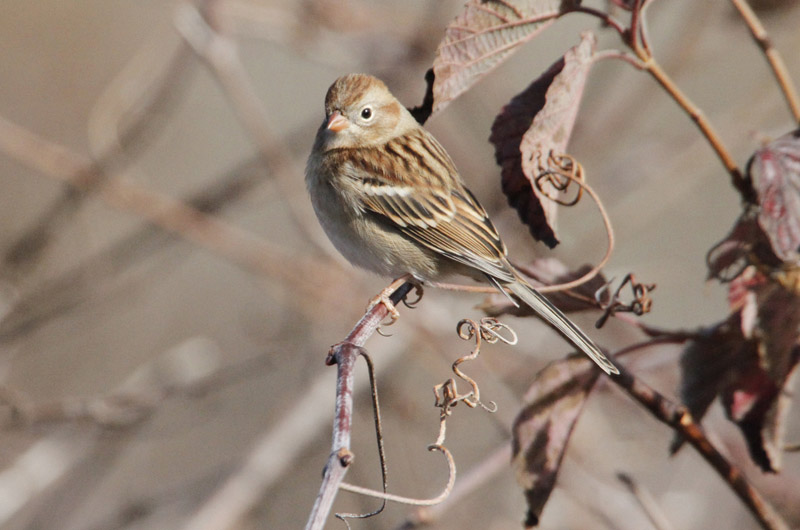Joyce and Hugh McCormick write that on Dec. 3 they observed two dozen dunlin and one dozen sanderlings at Little Beach in Edgartown. At East Beach the same day they had close to 50 loons — both common and red-throated, a dozen white-winged scoters, two northern gannets and three scaup in the Cape Pogue Gut.
Penny Uhlendorf had a winter wren visiting her suet feeder on Dec. 1. These tiny wrens — smaller than a black-capped chickadee — have been described as mouse-like. They typically pop into view briefly before they disappear back into the dense vegetation from which they came. Because of their small size and skulking habits, they are not reported very frequently although they are regular winter-time visitors. The next day, Ms. Uhlendorf had a pine siskin join her goldfinches at her thistle feeder.
Ken Magnuson found a gannet flying eastward toward Chappaquiddick on Dec. 3. Boyd Osler observed a few of them diving into the water off East Beach the same day. These large seabirds are masters of flight, and to see a flock of them plunge-diving into the water in search for fish is truly an experience you will not soon forget.
Purple finches are not easy to distinguish from their close cousins, the more abundant house finch. Both species can be very reddish-purple on their heads and backs, so their best distinguishing field mark is the brown streaking on the flanks of a house finch, while the flanks of a purple finch are unstreaked. Their songs are similar, but can be distinguished with experience. Matt Pelikan identified two purple finches as they flew overhead near his Oak Bluffs house on Dec. 4. Purple finches used to be fairly common on the Island, but now they are quite scarce. Please look carefully at those reddish finches at your feeder before you identify them as purple finches.
Also on Dec. 4, Ken Magnuson found a field sparrow at the Gay Head Cliffs. This small sparrow with a pink bill and an eye-ring may be visiting your feeder sometime this winter. The same day, Mr. Magnuson also observed a redhead (duck) in Chilmark Pond, three greater yellowlegs wading in the shallows of Katama Bay, and two female greater scaup in the deeper waters of Katama Bay.
On Dec. 6, Ken Magnuson found two Baltimore orioles along Herring Creek Road in Katama. As the annual Christmas Bird Count is rapidly approaching, on Jan. 2, it is time we start hoping birds like these late orioles hang around until then. It would be great to find them on count day!
And that same day John Nelson found six American pipits and 18 eastern meadowlarks in the Farm Institute fields. He also noted, as have many others, that there are large numbers of Bonaparte’s gulls feeding in the waters surrounding the Vineyard.
Dot Packer spotted a long-tailed duck near the head of Lake Tashmoo on Dec. 7. This is an unusual location for these ducks as they are usually out in the sound or the ocean. If you have an older field guide, this species will be called oldsquaw. Its name was changed awhile back.
Our resident fish crows continue to attract attention. It is hard not to notice a murder of 150 to 250 crows swooping and swirling around. A number of observers have reported on the 15-20 small fish crows that are frequently found at the Lagoon Pond boat launch ramp, but it is the larger flock that really draws attention. Sharon Simonin photographed this flock at East Chop near Crystal Lake in the middle of the day on Dec. 2. Lanny McDowell, Rosemary Hildreth and Matt Pelikan have recently reported them near the hospital. Mr. Pelikan, Tim Johnson and I have observed them between downtown Oak Bluffs and Farm Pond numerous times. They are only occasionally seen near Five Corners at dawn or dusk, which is where they were first observed in mid-November. Once, on Nov. 28, I observed about 50 of them in Brightwood Park near the shellfish hatchery, the first and only time I have found them near my house. And Ken Magnuson reports that about 150 of them are present in the Herring Creek Farm fields every day.
Maybe we can figure out their habits if we record how many crows we observe, the location and the time of day that we see this flock. Of course, they may be nomadic with no regular schedule. Mr. McDowell points out that many crows are likely to wipe out their supply of fruits and berries in fairly short order.
And these flocks are not our commuter crows that spend their nights on the Island and their days on the Cape or even in the New Bedford area. The commuter crows — both fish crows and American crows — still arrive on the Island in two locations between 2:30 and 4:30 in the afternoon, generally flying over East Chop between the lighthouse and the East Chop Beach Club and flying past the entrance to Lake Tashmoo heading inland toward Lambert’s Cove Road.
Finally, here is an update on Connie Alexander’s sighting of whales off Squibnocket Beach on Nov. 29. Pat Hughes, Flip Harrington and the Center for Coastal Studies in Provincetown all suggest they were most likely fin whales. An exciting find since whales are not commonly observed around the Vineyard.
There are lots of birds around, so please get out looking for them, and be sure to report your bird sightings to birds@mvgazette.com.
Robert Culbert leads guided birding tours and is an ecological consultant living in Vineyard Haven.





Comments
Comment policy »